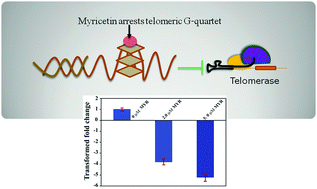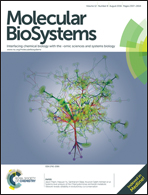Myricetin arrests human telomeric G-quadruplex structure: a new mechanistic approach as an anticancer agent†
Abstract
The use of small molecules to arrest G-quadruplex structure has become a potential strategy for the development and design of a new class of anticancer therapeutics. We have studied the interaction of myricetin, a plant flavonoid and a putative anticancer agent, with human telomeric G-quadruplex TTAGGG(TTAGGG)3 DNA. Reverse transcription PCR data revealed significant repression in hTERT expression in MCF-7 breast cancer cells upon increasing the concentration of myricetin. Further, we conducted a telomeric repeat amplification protocol assay to confirm the inhibition of telomerase by myricetin. Optical spectroscopic techniques like circular dichroism, UV spectroscopy and fluorescence spectroscopy revealed the formation of a stable myricetin–G-quadruplex complex. The thermodynamic parameters of myricetin–G-quadruplex complex formation, presented through isothermal titration calorimetry studies, indicate the binding process to be thermodynamically favorable. In addition, high resolution NMR spectroscopy in conjunction with molecular dynamics simulation is employed to provide detailed mechanistic insights into the binding in the myricetin–G-quadruplex complex at the atomic level. Our results thus propose a new mode of action of myricetin as an anticancer agent via arresting telomeric G-quadruplex structure.

- This article is part of the themed collection: Chemical Biology in Molecular BioSystems

 Please wait while we load your content...
Please wait while we load your content...